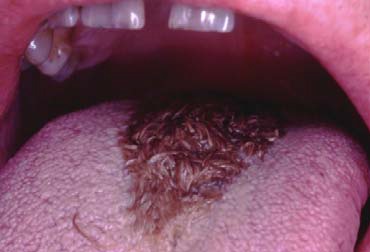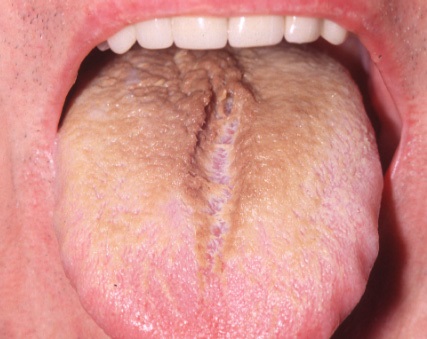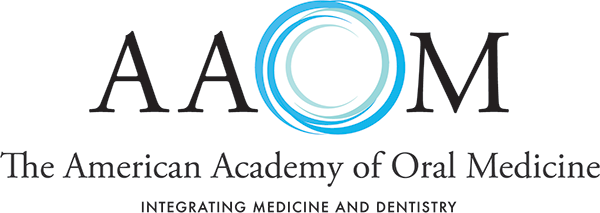Hairy Tongue
The term hairy tongue is used to describe an abnormal coating on the top (dorsal) surface of the tongue. It is a relatively common, temporary, and harmless condition that occurs in as much as 13% of the population.
Hairy tongue can occur at any age but is more frequent in older age. It is found more commonly in males than females and equally among races. In hairy tongue there is defective shedding of the tongue’s covering tissue. Normally the tongue is covered with conical shaped projections referred to as filiform papillae. Usually these papillae are approximately 1 millimeter in length.
 Hairy tongue occurs due to lack of stimulation / abrasion to the top of the tongue. The result is a buildup of a protein known as keratin (the same protein that makes up the hair on your head). In severe cases, the length of these papillae can become quite long, giving a hair-like appearance to the top of the tongue (see Below and Right). Also, when the papillae don’t properly shed, food, bacteria, and sometimes yeast can accumulate in the hair-like mesh. These accumulations result in various colors to the surface of the tongue. Hairy tongue may appear brown, white, green, or pink, depending upon the specific cause and other factors, such as mouthwashes or even candy. Certain types of bacteria and yeast can even give the tongue a black appearance, referred to as “black hairy tongue”. Hairy tongue occurs due to lack of stimulation / abrasion to the top of the tongue. The result is a buildup of a protein known as keratin (the same protein that makes up the hair on your head). In severe cases, the length of these papillae can become quite long, giving a hair-like appearance to the top of the tongue (see Below and Right). Also, when the papillae don’t properly shed, food, bacteria, and sometimes yeast can accumulate in the hair-like mesh. These accumulations result in various colors to the surface of the tongue. Hairy tongue may appear brown, white, green, or pink, depending upon the specific cause and other factors, such as mouthwashes or even candy. Certain types of bacteria and yeast can even give the tongue a black appearance, referred to as “black hairy tongue”.

QUESTIONS AND ANSWERS ABOUT HAIRY TONGUE
Q: What causes hairy tongue?
A: It can occur from poor oral hygiene (mouth cleaning), the use of medications, chronic or extensive use of antibiotics, radiation treatment to the head and neck area, excessive coffee or tea drinking, or tobacco use. It may also develop in persons with no teeth because their soft food diet does not aid in the normal shedding of the papillae.
Q: Does hairy tongue hurt?
A: There are usually no symptoms but occasionally there is a burning sensation on the tongue associated with the bacteria or yeast accumulations. Individuals with hairy tongue may also complain of gagging or a tickling sensation in the soft palate (roof) of the mouth during swallowing. Halitosis (bad breath) or abnormal taste may be present due to the taste buds (papillae) holding onto debris in the mouth.
Q: How is the diagnosis of hairy tongue made?
A: In most instances, dentists or health care providers can make the diagnosis based on clinical appearance. Biopsy of hairy tongue is not necessary.
Q: How do I get rid of hairy tongue?
A: In most instances good oral hygiene with a toothbrush or tongue scraper will result in elimination of the build up. Individuals with a persistent coating on the tongue should consult their dentist or other trained oral health professional. Hairy tongue that does not resolve with such simple measures may be treated with medical or surgical treatments by qualified individuals.
Q: How can I prevent hairy tongue?
A: Most individuals can prevent hairy tongue by practicing good oral hygiene. Brushing the top of the tongue with a tooth brush should be part of regular daily oral hygiene activities. Many individuals are sensitive and have a tendency to “gag’ when accomplishing this procedure. Using a small brush and gradually going backwards tends to lessen this problem. A number of tongue cleaning devices (tongue scrapers) are available. If you continue to have a problem cleaning your tongue, consult your dentist or an individual with experience in this area.
Q: Will hairy tongue come back?
A: The key to successful long-term elimination is excellent oral hygiene. Patients who have had hairy tongue are at greater risk for recurrence.
Prepared by L Radfar and the AAOM Web Writing Group
Reviewed 13 May 2015
Japanese Translation - 日本語訳
Spanish Translation - Traducción Español
The information contained in this monograph is for educational purposes only. This information is not a substitute for professional medical advice, diagnosis, or treatment. If you have or suspect you may have a health concern, consult your professional health care provider. Reliance on any information provided in this monograph is solely at your own risk. |

 Hairy tongue occurs due to lack of stimulation / abrasion to the top of the tongue. The result is a buildup of a protein known as keratin (the same protein that makes up the hair on your head). In severe cases, the length of these papillae can become quite long, giving a hair-like appearance to the top of the tongue (see Below and Right). Also, when the papillae don’t properly shed, food, bacteria, and sometimes yeast can accumulate in the hair-like mesh. These accumulations result in various colors to the surface of the tongue. Hairy tongue may appear brown, white, green, or pink, depending upon the specific cause and other factors, such as mouthwashes or even candy. Certain types of bacteria and yeast can even give the tongue a black appearance, referred to as “black hairy tongue”.
Hairy tongue occurs due to lack of stimulation / abrasion to the top of the tongue. The result is a buildup of a protein known as keratin (the same protein that makes up the hair on your head). In severe cases, the length of these papillae can become quite long, giving a hair-like appearance to the top of the tongue (see Below and Right). Also, when the papillae don’t properly shed, food, bacteria, and sometimes yeast can accumulate in the hair-like mesh. These accumulations result in various colors to the surface of the tongue. Hairy tongue may appear brown, white, green, or pink, depending upon the specific cause and other factors, such as mouthwashes or even candy. Certain types of bacteria and yeast can even give the tongue a black appearance, referred to as “black hairy tongue”.